Murderers of their own wives and children, sadists who enjoy torture, cruel rulers exterminating their subjects. This is how you can describe the behavior of many rulers of ancient Russia. We present the five worst of the worst.
5. Catherine II - ambitious and bloodthirsty
She is considered an outstanding ruler who brought Russia greatness. At the same time, however, she was duplicitous, ruthless and morbidly ambitious. She posed as an enlightened ruler, but resorted to unprecedented cruelty in the governments. She came to power as a result of a conspiracy against ... her own husband Peter III. In the summer of 1762, rebels supported by the guard seized power, and Piotr was murdered by officers. Catherine could take the throne.
When in 1773 a great peasant rebellion broke out under the leadership of Jemelian Pugachev, whose participants demanded the abolition of serfdom, the Tsarina firmly set about drowning him in blood. Hundreds of peasants and Cossacks died under the executioner's ax, many were exiled to Siberia. Bloody terror has raged in Russia. Mass executions were carried out. Pougatcheff himself was captured, transported like an animal in an iron cage to Moscow and publicly beheaded in Bolotny Square.
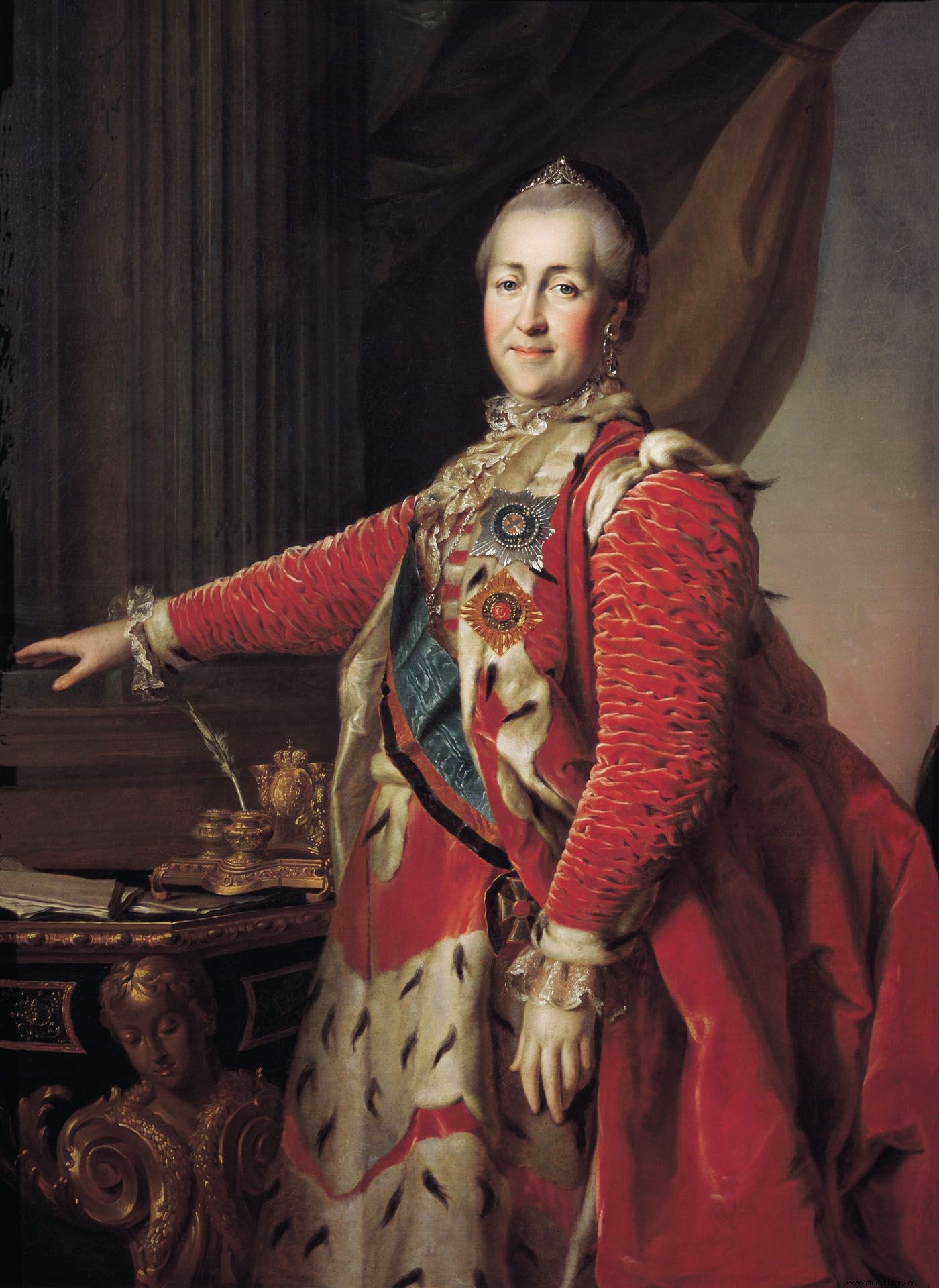
Catherine II posed as an enlightened ruler, but this did not prevent her from allowing the trade in peasants. The Tsarina in the portrait by Dmitry Grigorjewicz Lewicki from 1782 (source:public domain).
4. Nicholas I - a violent despot
He began his reign with a strong accent - suppressing the rebellion of young officers of the guard, known as the Decembrist uprising. Ordered to open cannons to 3,000 rebellious soldiers and a crowd of civilians on Senate Square in St. Petersburg. 80 people died from the missiles, and several hundred more died during the panic escape of people through the frozen and constantly fired upon Neva. The policemen simply threw the injured in an ice hole.
The captured conspirators were investigated. They were taken to the Peter and Paul Fortress, where they were subjected to torture, which Russia had not seen for a long time. The tsar himself conducted the investigation. The Decembrists spent their companions on the races at the cost of less sentence on the races and burdened their colleagues, and then, with tears in their eyes, they fell into the hands of Mikołaj.
The sentences were handed down to 289 people, and five leaders of the conspiracy were sentenced to death. It was taken in a landfill near St. Petersburg. The rest were sent to Siberia. It was the appropriate beginning of the tsarist reign, which a century later would find a follower in the person of Stalin - writes Michael Farquhar in the book "Secrets of the Tsars. Intrigues, scandals and crimes of the Romanovs ”.
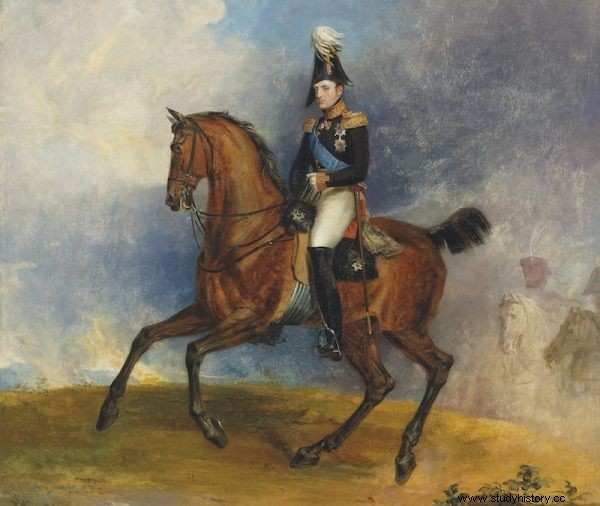
So young… and already so cruel. Equestrian portrait of Nicholas I by George Dawe from 1822 (source:public domain).
The tsar was violent and despotic. He was a supporter of a strong, authoritarian power, and he wanted to keep society as a whole under control. He expanded the police system, created the Third Division of the Personal Office, i.e. the secret police, dealing with surveillance.
In spite of the developing world, Nicholas I restored autocracy resembling the rule of Ivan the Terrible. By ruthless methods, he made himself the only center of power, responsible only to God. "Everything must begin here," he would say, pointing to his chest - we read in "Secrets of Cars" .
After suppressing the November Uprising in the Kingdom of Poland, he embraced its participants with severe repressions. In 1832 alone, he issued as many as 12 repressive decrees. He encouraged the commissions judging the insurgents with the words:"Sternly and sternly!" He had tens of thousands of Polish soldiers recruited by force into the Russian army and sent to the Far East and Siberia.
3. Nicholas II - a limited tyrant
The last tsar of Russia was considered a limited man and deprived of the ability to govern. He also believed that all ideas that threaten self-lease and the unity of the state should be fought. That is why he did not hesitate to persecute the opposition, imprison its participants and condemn them to heavy sentences. The tsar's entourage convinced him that in view of the internal difficulties caused by Russia's traitors and the nation's dealers, as well as in the face of the aggravating international situation, the subversives should be treated with all severity.
In 1904, Nicholas recklessly joined the war with Japan, which Russia lost grossly, losing over 30,000 on the battlefields. killed and almost 150 thousand. injured. The defeat sparked an outbreak of social discontent that turned into a revolution. Citizens demanded a departure from authoritarianism, liberalization, and improvement of working conditions. What did the tsar do? He proceeded to suppress the protests by sending troops and the police against his own subjects.
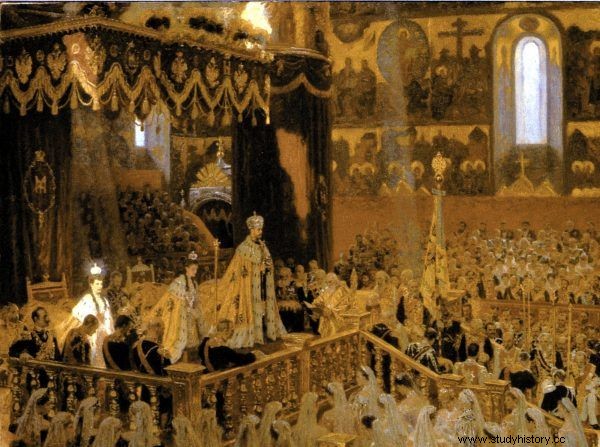
Nicholas II, though rather kind and gentle by nature, was the wrong man in the wrong place. And his greatest sin was his unwavering belief in the limitlessness of his own power, despite the lack of competence to exercise it. The painting shows the coronation of Nicholas II and his wife Alexandra Feodorovna by Laurits Tuxen (source:public domain).
When on January 22, 1905 in St. Petersburg, a 200,000-strong peaceful workers demonstration led by Georgy Gapon marched to the Winter Palace carrying portraits of the tsar and singing songs, military troops came out in front of it and opened fire. About a thousand people died. In the opposition Russian and foreign press, the tsar began to be called "the murderer" and "Nicholas the Bloody".
This is not the only case in which Mikołaj has human lives on his conscience. Strikers and demonstrators were also shot in other cities of Russia, and the protests in the Kingdom of Poland were brutally and bloodily suppressed.
The number of victims of the revolution of 1905 is difficult to precisely determine. 14 thousand killed and 75 thousand. imprisoned. This, however, is nothing compared to the victims Russia suffered in the First World War, into which it was involved in the tsar. The losses of the Russian army amounted to approximately 1.7 million dead and dead, almost 5 million wounded, and 2.5 million prisoners and missing persons.
2. Ivan IV the Terrible - sadist and psychopath
This Grand Duke of Moscow and the first Tsar of All Russia pursued a policy of strengthening the state and expanding its borders. However, he went down in history because of his extreme cruelty or even sadism.
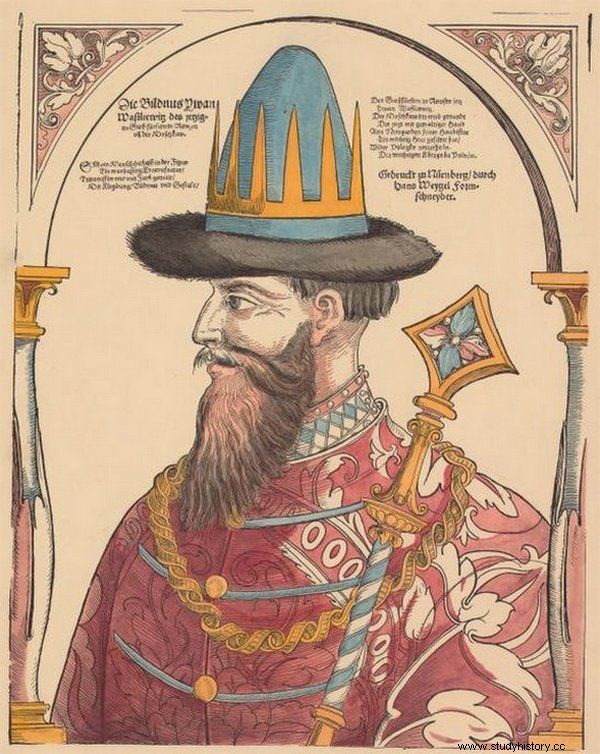
Ivan IV the Terrible went down in history as a cruel and sadist. No wonder, since he liked to kill from his childhood ... Portrait of the Tsar prepared by Ch. Weigl in 1882 (source:public domain).
He has been fond of killing since childhood. As a boy, he tormented animals. He threw the puppies from the Kremlin walls and gouged out the eyes and entrails of the caught birds. After assuming power, he murdered relatives and boyar families that could threaten him. During the so-called opryczniny introduced a bloody terror directed against the powerful and, more broadly, the elites of the state. The arrested were broken with a wheel, castrated and torn with tongs.
In 1570, Ivan slaughtered the inhabitants of Novgorod, allegedly conspiring with the king of Poland, Sigismund Augustus. The murders lasted five weeks.
The inhabitants were tortured, skinned, drowned in the river and burned alive. Children were tied to their mothers and thrown together into the water, and soldiers who were melted in ice-holes cut off their fingers when they wanted to get out from under the ice. Hundreds of monks were beaten with sticks. The tsar drove a sleigh on people piled on the snow. In Nowogród, 25 thousand people were killed. up to 60 thousand people.
In the summer of the same year in Moscow, Ivan ordered the execution of several hundred people accused of treason. One of the inmates was doused alternately with hot and icy water until his skin began to peel away from his body. Another was cooked alive, still others were cut up alive or skinned. The tsar's incredible cruelty also affected his relatives: during an argument he personally killed one of his sons , he also murdered four of his seven wives.
1. Peter I the Great - tyrant reformer
Tsar Peter I the Great went down in history as a reformer who modernized Russia, directed it to the West and made it a major force in European politics. But he, too, was marked by brutality and cruelty towards opponents and subjects. Even as a youth, he would get angry easily, and then he would attack his companions and hit them with his fists. He spared no one. Sometimes, in a fit of rage, he would crush the fingers of his teachers and colleagues, kick them and abuse them.
As a tsar, he ruthlessly obeyed orders, and officials trembled in fear of him. A certain head of the college of foreign affairs, unable to cope with the task, cut his wrists out of fear of the tsar.
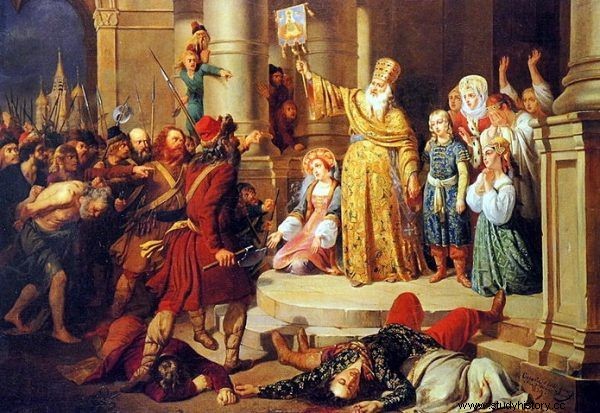
Peter I the Great had a tendency to sadism as a child. It is possible that they became stronger when, as a 10-year-old, he watched the cruelty of the shooters' rebellion. In this Octavie Rossignonz 1839 painting, the little tsar is standing next to the patriarch - and in front of the corpse (source:public domain).
When Peter returned to Moscow from his travels in Europe in the summer of 1698, he publicly cut the beards of several of his dignitaries as a welcome message. Humiliated and terrified by such a greeting, the dignitaries still had to thank the tsar for the grace he had done for them. They were lucky anyway, they might have lost their heads anyway.
This is what happened with the participants of the rifle mutiny, whom Piotr dealt with much more brutally. During the investigation, their testimonies were extracted with cruel torture:their hands were clasped with forceps, their bodies were stretched, and they were burned with fire. Some of them were personally interrogated by the tsar, setting an example of his lack of pity and enjoying watching them suffer.
The death sentences that were passed provided for dismemberment, beheading and hanging. The executions were public and residents were encouraged to watch them. The sentence was carried out by close associates of Piotr, who then bragged about the number of heads cut off. A friend of the tsar, Alexander Menshikov, beheaded 20 people. Unfortunately, he was not experienced in executions, which is why he often did not hit the neck, but the head of the condemned man, which he smashed ...
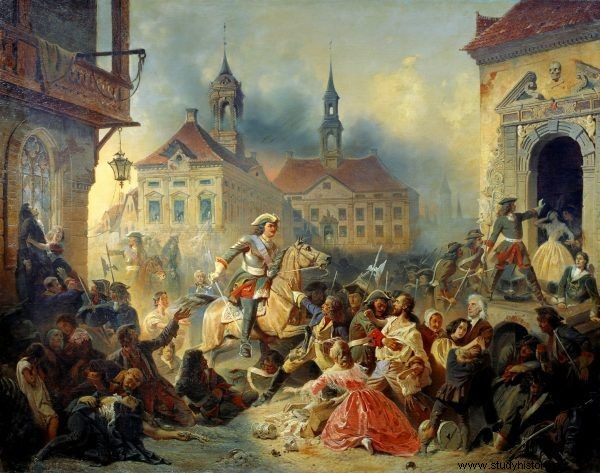
Ruthless punishment by Peter I was the norm. In this painting by Nikolai Sauerweid from 1859, we see him dealt with the marauders after conquering Narva (source:public domain).
The heads and bodies of the hated shooters were made macabre in Moscow exhibition; some bodies were hanging from the Kremlin walls. "What for a strange guard! " - Korb is amazed [Johannes Korb, Austrian envoy - ed. PS] on the pages of the diary. Those who survived the massacre, had to live without ears and noses until the end of their days, which were cut off from them, and the shooters' units were disbanded forever Writes Michael Farquhar. A total of 971 people were executed in Preobrazhensk and Moscow.
This is nothing compared to the number of casualties the tsar ordered to build St. Petersburg. The erection of the city took place in very difficult conditions:in a swampy, swampy area, in low winter temperatures and an unfavorable climate. Often there was a shortage of everyday items, and everything, including food, had to be brought from the south of Russia. The number of victims of the "city on bones" is difficult to determine precisely; it is estimated very broadly:from 30 thousand. up to 300,000 people.
